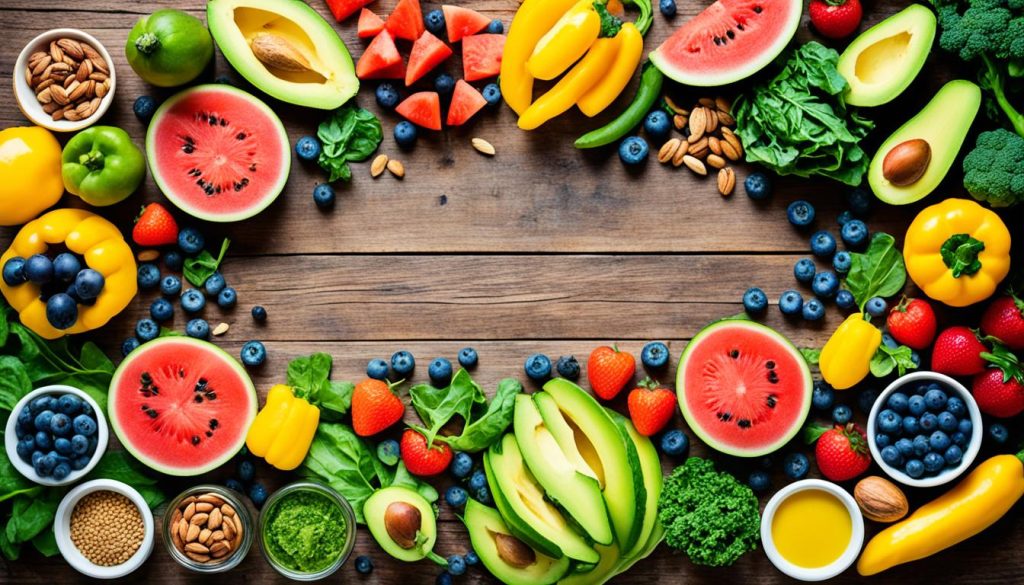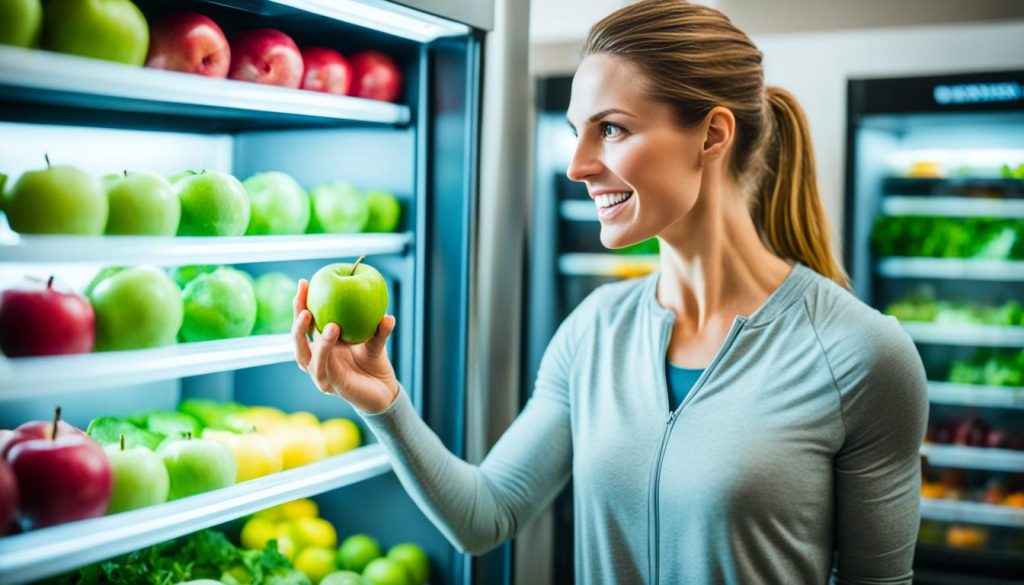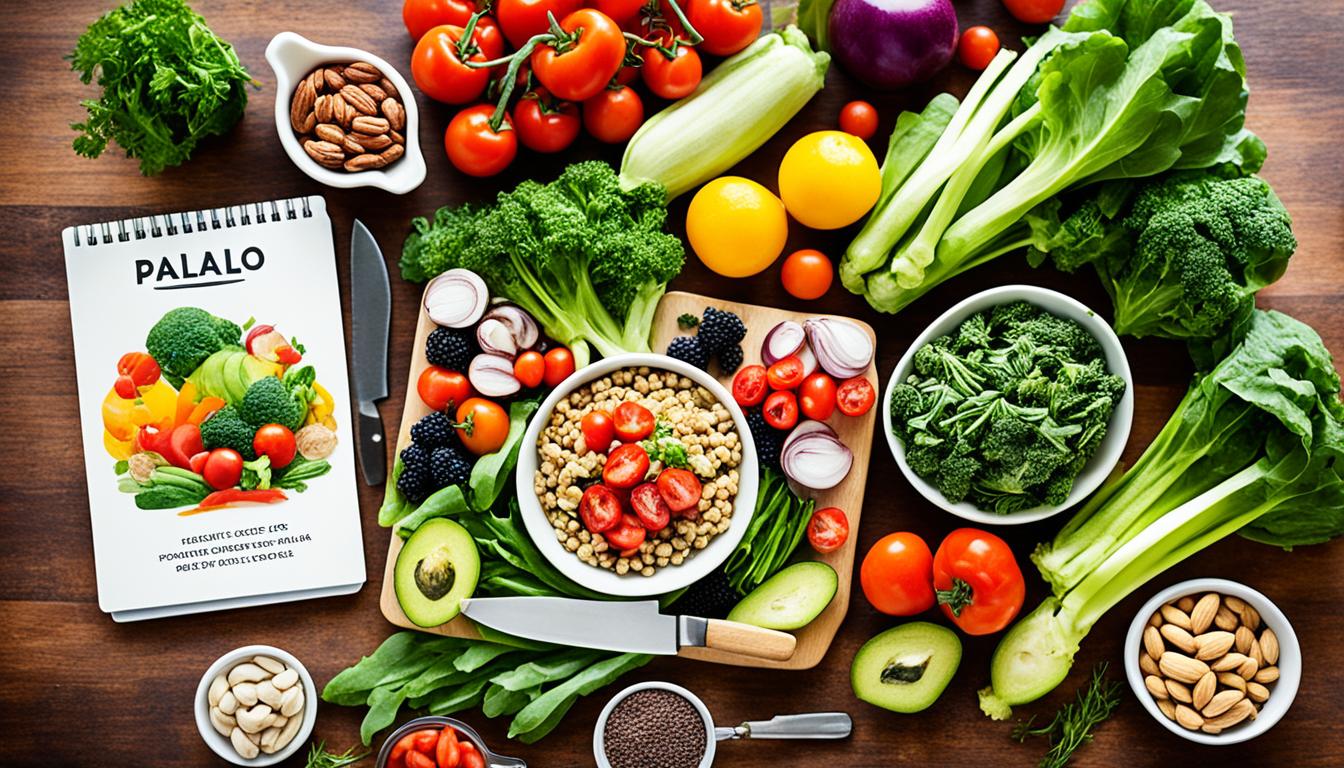Have you ever thought about if our diets today are too different from what our bodies need? The Paleo diet might offer the answers you seek. This guide will introduce you to a lifestyle inspired by our ancient ancestors.
The Paleo diet focuses on natural, unprocessed foods, similar to what our Paleolithic ancestors ate. It includes whole foods like meats, fish, fruits, vegetables, nuts, and seeds. This can lead to a healthier and more balanced life.
Exploring the diet’s core principles can change how you eat and improve your health. Are you ready to begin? Let’s start with the key paleo diet basics and help you succeed.
Quick Recommendation: Our blog takes you through getting started on a paleo diet. If you're interested in exploring the paleo diet more comprehensively, we recommend the Living Paleo - Video Course.
What is the Paleo Diet?
The Paleo diet is often called the caveman diet. It’s a modern eating plan based on what our Paleolithic ancestors ate. It focuses on whole foods and avoids processed ones. This diet is part of paleolithic nutrition, aiming to improve health by eating like our hunter-gatherer ancestors.
This diet includes meat, fish, veggies, fruits, nuts, and seeds. Foods like dairy, grains, and legumes are usually not eaten because they came later with farming. It’s different from today’s diets, which often have lots of sugar and processed foods.

The Paleo diet focuses on natural, nutrient-rich foods to fight health problems like obesity and chronic diseases. It encourages a simpler, healthier way of eating, inspired by our early ancestors. So, paleolithic nutrition is a way to get healthier and connect with our dietary past.
Benefits of the Paleo Diet
The Paleo diet offers more than just a change in eating habits. It can lead to weight loss by focusing on natural foods. This means you eat fewer calories without feeling hungry.
Another big plus is the boost in energy. Eating whole foods gives you energy that lasts all day. You’ll feel more energetic for your daily activities and won’t get tired easily.

Your digestion can also get better with the Paleo diet. By avoiding processed foods and choosing nutrient-rich ones, your digestive health improves. Some people find that cutting down on grains and dairy helps with digestion too.
Studies and experts like Dr. Loren Cordain support the Paleo diet’s benefits. These include less inflammation and better metabolic health for long-term wellness. Switching to this diet is a simple way to improve your health and well-being.
Essential Foods on the Paleo Diet
The Paleo diet focuses on foods our ancestors ate. You’ll eat natural, unprocessed foods. Lean meats are key, like grass-fed beef, free-range poultry, and wild-caught fish. These foods are tasty and full of nutrients your body needs.

Adding organic vegetables to your meals is also important. Foods like kale, spinach, and broccoli are full of vitamins and minerals. They help keep you healthy. Choosing organic means avoiding pesticides and harmful chemicals.
Superfoods are also a big part of the Paleo diet. Chia seeds, nuts, and berries are packed with nutrients. They offer antioxidants, fiber, and essential fatty acids. These foods are great for your health.
Foods to Avoid on the Paleo Diet
Following a Paleo lifestyle means avoiding foods not typical of ancient diets. It’s key to know what to skip to stick to the diet and stay healthy.
Processed foods are a big no. They often have additives and artificial stuff that Paleo doesn’t allow. Stick to whole foods to keep your diet true to Paleo.
Grains like wheat, rice, and corn are also off-limits. They can be hard to digest and cause inflammation. Gluten in grains is a big reason people avoid them on Paleo.

Dairy products are also on the list to avoid. Many are processed and can upset some stomachs. Cutting out dairy helps with digestion and overall health.
Legumes, including beans, lentils, and peanuts, are not Paleo-friendly. They can affect how your body absorbs nutrients and digests food. Instead, choose veggies and proteins that are rich in nutrients.
Being careful with these foods helps you follow the Paleo diet better. It lets you enjoy the diet’s health benefits fully.
How to Transition to a Paleo Lifestyle
Starting a Paleo lifestyle might seem daunting, but it can be made easier with the right steps. Begin by making small changes, like swapping processed snacks for fresh fruit or nuts. Clearing out non-Paleo foods from your pantry is also a good first move.

After making these initial changes, focus on lifestyle adjustments that support your new diet. This means choosing whole, unprocessed foods whenever you can. Shopping at farmers’ markets or in the outer grocery store aisles can help.
Meal planning is key when you’re on a paleo diet. It helps you always have healthy options ready, preventing old habits. Spending time on meal prep, like cooking in bulk and storing food for later, saves time and effort during busy weeks.
By slowly adding these lifestyle changes and sticking to meal planning, transitioning to a Paleo lifestyle becomes easier. Keep at it, and you’ll likely see the many health benefits of this diet.
Quick Recommendation: Our blog takes you through getting started on a paleo diet. If you're interested in exploring the paleo diet more comprehensively, we recommend the Living Paleo - Video Course.
Paleo-Friendly Recipes to Get You Started
Starting a Paleo journey might seem tough, but easy paleo recipes make it easy. Whether you’re a pro in the kitchen or new to cooking, beginner paleo meals help you eat healthy.
Begin your day with a Paleo breakfast: a veggie-packed omelet. Whisk eggs and pour over sautéed spinach, bell peppers, and onions. These ingredients are packed with nutrients and help you start the day right.
For lunch, try a refreshing avocado chicken salad. Mix shredded chicken, creamy avocado, and crisp lettuce with a lemon-tahini dressing. It’s a great mix of protein and healthy fats, perfect for beginners.
Dinners can be just as tasty with dishes like roasted salmon and sweet potato fries. Season the salmon with herbs and bake until it’s tender. Serve with crispy sweet potato fries for a meal that’s both filling and healthy.
Snacks are key, and easy paleo recipes make them simple. Think homemade trail mix with nuts, seeds, and dried fruit. It’s a quick way to get energy and stay on track with paleo.
Adding these simple and tasty recipes to your daily meals makes switching to Paleo smooth and fun. Happy cooking!
Common Misconceptions About the Paleo Diet
Many people misunderstand the Paleo diet, leading to a lot of myths. One big myth is that it’s all about eating a lot of meat. But, the diet really focuses on eating a mix of fruits, vegetables, nuts, and seeds for balanced nutrition.
Some think the Paleo diet cuts out all carbs. This isn’t true; followers can eat foods like sweet potatoes and root vegetables. The goal is to eat foods that are full of nutrients and not too processed.
Another myth is that the Paleo diet is too hard to follow. It can be tough to give up processed foods at first. But, many people find it easy and fun once they adjust to eating differently. Knowing these facts can help you see if the Paleo diet is right for you.
Shopping Tips for the Paleo Diet
Shopping for the Paleo diet means looking for whole, natural foods. It can be tough to find these items. Here are some tips to make shopping easier and save money.
Start by planning your meals for the week. This way, you can make a shopping list and avoid impulse buys. Buying seasonal produce is also a good idea because it’s fresh and cheaper.
Buying in bulk is another smart move. Things like nuts, seeds, and dried fruits are cheaper when bought in large amounts. Also, watch for sales on meat and produce. These items are key to the paleo diet and often go on sale.
Don’t forget to check out local farmers’ markets. They offer fresh, organic paleo foods and let you meet the farmers. You can learn about how your food is grown and raised.
Look at different stores for different items. Health food stores have a great selection but can be pricey. For cheaper options, try discount stores for pantry items and big-box stores for bulk purchases.
Lastly, know which foods fit the paleo diet. Learn to read ingredient lists and nutrition labels. This makes shopping easier and less stressful.
Exercising on the Paleo Diet
Pairing a paleo fitness plan with your diet boosts your health and well-being. The Paleo lifestyle means eating right and staying active for the best results. Regular exercise with the Paleo diet makes you feel more alive and full of energy.
When making your paleo fitness plan, focus on natural movements. HIIT, bodyweight exercises, and functional training are great choices. These exercises match the Paleo way and build strength, endurance, and agility. Here are some tips for your workouts:
Begin with short, intense workouts. This method is effective and suits a busy life. As you get fitter, increase the intensity and time of your workouts.
Being consistent is vital. Exercise should be a regular part of your life for the best results. Try to do at least 30 minutes of activity most days.
Always pay attention to your body. Rest and recovery are important for any fitness plan. They help prevent injuries and let your muscles heal and get stronger.
Combining a balanced paleo fitness plan with your diet changes your health for the better. Eating right and exercising together uses the Paleo lifestyle to the fullest. It leads to long-term wellness and vitality.
Potential Challenges and How to Overcome Them
Starting a Paleo lifestyle can be rewarding but also tough. You’ll need determination and a good plan to overcome paleo obstacles. Common challenges include handling social situations, meal prepping, and getting used to new foods.
Social situations can make sticking to Paleo hard, especially when there are non-Paleo foods around. To deal with this, plan ahead. Bring your own Paleo dishes to share. This helps you stay on track and shows others tasty Paleo options, easing the pressure.
Meal prepping can be a challenge too. It’s important to find a routine that works for you. Set aside time each week for grocery shopping and meal prep. Having a plan and advice can really help. Prepping big batches of your favorite Paleo dishes saves time and keeps you ready with healthy options.
Trying new foods can feel overwhelming at first. Get to know local farmers’ markets or online places for quality, organic food. Always check labels and be aware of hidden ingredients to stay on track with the Paleo diet.
Being consistent is key. Setting realistic goals and getting support from online groups or friends on Paleo can help. Every step towards Paleo is a step towards better health and a happier you.
Conclusion
Starting a paleo diet can change your life, bringing many health benefits and a new way of thinking about food. We’ve looked at the basics of the Paleo diet, from its ancient beginnings to how people follow it today. Eating whole foods like lean meats, fruits, and veggies helps you eat like our ancestors, which can make you healthier.
We talked about the key foods to eat and avoid, and how to easily switch to a Paleo lifestyle. It might seem hard at first, but with effort and good advice, it can be rewarding. Many people have seen great results from eating Paleo, proving it can really help.
If you want to get fitter, think clearer, or just feel better every day, the Paleo diet can help. Be brave and start your journey to a healthier you. Remember, the biggest changes start with trying something new.
Quick Recommendation: Our blog takes you through getting started on a paleo diet. If you're interested in exploring the paleo diet more comprehensively, we recommend the Living Paleo - Video Course.

